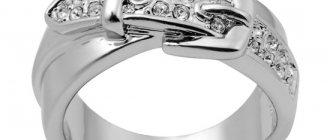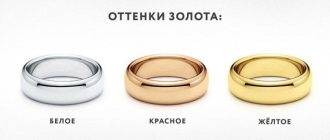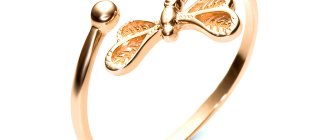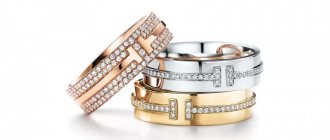Yellow gold
The traditional and most familiar color of gold to the eye is yellow. This is exactly what pure metal has.
In jewelry, silver and copper are added to it. The more silver, the lighter the alloy. To obtain a lemon tint, increase the percentage of silver ligature. For warmer, sunny conditions – copper.
The fineness of gold depends on the amount of alloy - additional metals. For example, 14k yellow gold, which is most often used for jewelry, is a metal with the addition of 28% silver and 13.5% copper.
Gold products of a bright yellow color look less noble, and they are inferior in quality. They are made from an alloy of gold with copper, silver and palladium; this is the lowest standard - 375.
What kind of gold is there?
In jewelry stores you cannot find jewelry made from pure gold of 999.9 purity (fine gold), and all because this metal itself is very plastic and deformable. In its pure form, it can only be found in the form of bars stored in banking institutions. In jewelry, gold is combined with other metals, which not only gives it a different hue, but also makes it more durable. Metals added to gold are called alloys.
The most popular types of gold among jewelry lovers are:
- White: is gold combined with platinum, nickel, silver (optionally palladium). This metal is popular among buyers, since jewelry made from it harmonizes with any photo type of appearance. In addition, white gold emphasizes the beauty of precious stones, which cannot be said about pure metal.
- Red: To obtain this type of gold, copper and zinc are added to the base metal. Jewelry made from this alloy has a red tint precisely because of the copper. It is believed that wearing rings, bracelets and other jewelry made from it has a healing effect.
- Yellow: in color it resembles fine gold, but the purity of this gold is 585: one kilogram (1000 grams) of the alloy contains only 585 grams of gold, and the rest is represented by a ligature. It turns out that fine gold and alloy in such an alloy are in equal proportions. If you want to get a warm shade of yellow gold, then silver and copper are added in a ratio of 2 to 1. To obtain a more saturated shade, copper and silver are taken equally.
- Gray: similar to white, but this alloy contains, in addition to gold, nickel, zinc and silver.
- Black: This metal has unparalleled beauty and value to match, as getting the perfect black gold is not an easy task. This metal looks great in combination with white gold and diamonds.
There are other varieties of gold, for example, purple, green, blue, but due to their fragility they are used as a metal for making inserts in precious jewelry.
White gold
Products of a steel cold shade are slightly inferior in popularity to sunny yellow. White gold goes well with diamonds, making their shine more expressive. Products without stones are also held in high esteem: they go with everything, look noble and elegant.
This color of metal is obtained by adding palladium, nickel, silver or platinum to gold. The alloy with platinum is the most valuable and durable; jewelry made from it does not scratch, does not deform, and retains its attractiveness for a long time.
The cheapest white gold is with a nickel alloy. Products made from such an alloy wear much worse and can also cause allergies. Nickel gives white gold a slight yellowish tint.
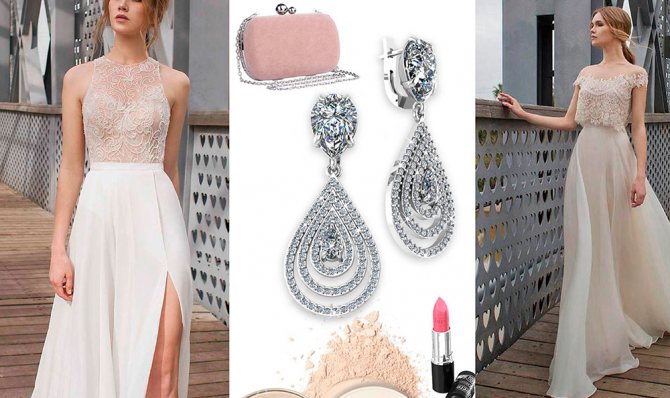
Red and rose gold
The alloy acquires such shades thanks to copper. Copper has a good effect on the properties of finished products, giving them strength and durability.
Do not confuse red and red gold. The first contains about 50% copper alloy and has a frankly reddish tint. The second is named after chervonets - gold coins made of almost pure gold.
Romantic pink color usually indicates 585 metal. It is made in the following proportions: 14 parts gold, 7 or 8 parts copper, 2 or 3 parts silver.
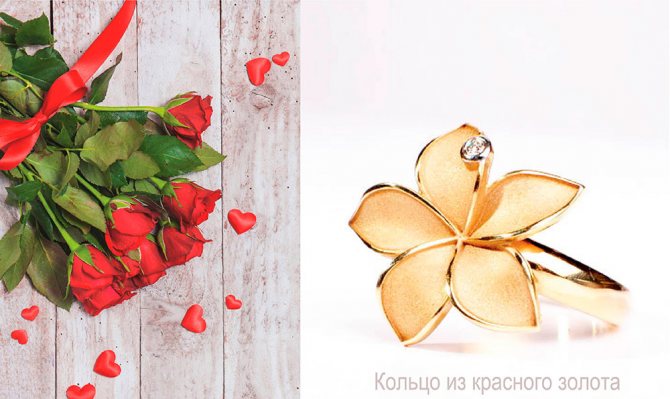
Green gold
The unusual shade of the metal is the result of an alloy of gold and silver. The higher the percentage of silver in the alloy, the paler its tone. At 30% silver, the metal practically loses its yellowness: it becomes silver with a slight greenish tint. This alloy is called electrum. If you alloy gold with cadmium and zinc in certain proportions, you will also get a metal with a greenish tint.
Jewelry made from this alloy is rare. They look unusual, but due to their composition they turn out to be quite fragile, almost unsuitable for wear. Green gold is sometimes used in combination with other colors, such as white.

Acrylic paint “Decolor Decorative” Old Gold 50ml
Decorative acrylic paint "Decolor" is used to imitate gold.
After the water evaporates, Decolor acrylic paint forms a dense, water-resistant paint layer that has a high degree of resistance to mechanical stress and direct sunlight - Decolor decorative acrylic does not fade for ten years. Therefore, Decolor paint is widely used for gilding exterior elements.
Many restorers and designers choose gilding with acrylic paint, due to the excellent properties of acrylic:
- acrylic paint does not smell, which means there is no need to equip a special place for working with the hood;
- the paint is very convenient to use: acrylic paint is applied with a brush, roller or spray;
- decorative acrylic “Decolor” has a high degree of adhesion to almost any grease-free surface;
- the paint layer dries within an hour;
- acrylic paint "Decolor" offers a wide selection of ready-made gold and other metallic shades, and to obtain new shades and varying degrees of saturation, paints can be mixed in any ratio;
- the fluid consistency makes it easy to spread the paint even on difficult terrain;
- Acrylic paint "Decolor" has a unique proven durability of the finished coating.
Permanent decorative paint "Decolor" is widely used for arts and crafts, used for restoration, decoration and design work, in the finishing of interior and facade elements to give the overall ensemble expressiveness. The high quality and protective and decorative properties of Decolor paints have been confirmed by tests at the St. Petersburg Research and Design Institute for the Restoration of Historical and Cultural Monuments; Decolor paints are recommended by KGIOP for restoration work on the facades of legal buildings (letter No. 3-6328-1 from 03.10.2006).
“Decolor” paint is used to imitate the gilding of church domes; it was used to decorate the St. Nicholas Cathedral and the Yusupov Palace in St. Petersburg. These paints are used in the work of decorators at the Mariinsky and Bolshoi theaters. “Decolor” was also used during the restoration of the VDNH pavilions (photos can be viewed in the gallery below).
Mode of application:
All types of paper and cardboard, dissimilar surfaces from natural stone to finishing building materials, glass, plastic and metal are used as a substrate for working with acrylic decorative paint “Decolor”. Paint is applied to a previously prepared, dry and clean surface. It is recommended to prime hygroscopic and porous materials to match before painting. If desired, the paint can be diluted with acrylic varnish or water. To work with Decolor acrylic paint, use a brush, sponge or roller. Coloring should be carried out at ambient temperatures above 10°C.
After finishing work, you should wash the used tools and containers. To store started packaging, it is recommended to close the container tightly to avoid drying out. Acrylic paint dries quickly in air.
To mix with Decolor, use only acrylic paints.
Color: Old Gold
Volume: 50 ml
Blue, blue and purple gold
To obtain a delicate blue tint, a cobalt ligature is added to the metal or rhodium plating is applied. Some manufacturers add indium to obtain “heavenly” gold.
Mixing gold with steel produces an unusual blue metal. When potassium or aluminum is added, the alloy acquires a purple tint.
Remember: decorative types of gold do not have a pronounced color, but only cast in one shade or another. If the seller offers you gold of a rich color - red, blue, light blue or green, it is most likely just a coating.

Brown (brown) gold
These are alloys with copper, usually 750 or 585 samples. The characteristic brown tint is the result of chemical processing of the metal. Reddish-brown gold is made with the addition of copper, silver and palladium. The alloy is not so often used in the production of jewelry; it is mainly used to make watch parts. It turns out to be hard and durable - this is what good mechanisms need.
You rarely see jewelry made from this alloy, but they fascinate with their beauty. The alloy itself is quite expensive; products made from it are encrusted with diamonds and other precious stones.
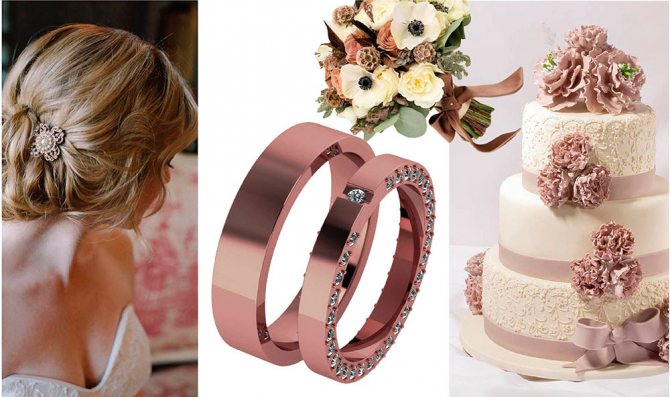
The whole “palette” of gold
Most often, the most noble metal is combined with copper and silver, less often with palladium, platinum, zinc, etc. It must also be taken into account that the final shade will be influenced by the level of skill of the manufacturer. Let's tell you more about possible combinations and colors.
Reference yellow
Bank bullion has the familiar bright shine and bright yellow tint. They are made from processed 999-carat gold.
From orange to red
Reddish and orange shades are characteristic of metal with a low purity (375). Copper and silver are added to it. To get orange, you need to take a lot of silver.
If the task is to give the material reddish tones, copper is used in larger quantities. And the romantic and elegant pink metal is “mined” from 75% gold, 16% copper and 9% silver. Rose gold pendants and rings are usually given as a token of love.
White
Jewelry made from light alloy looks both elegant and expensive. As a rule, they have a 750 sample. Silver and palladium contribute to the white coloration. To reduce the cost, palladium can be replaced with nickel, but this significantly reduces the quality and poses a health hazard. Wearing chains, bracelets and other items containing nickel provokes the appearance of allergic symptoms.
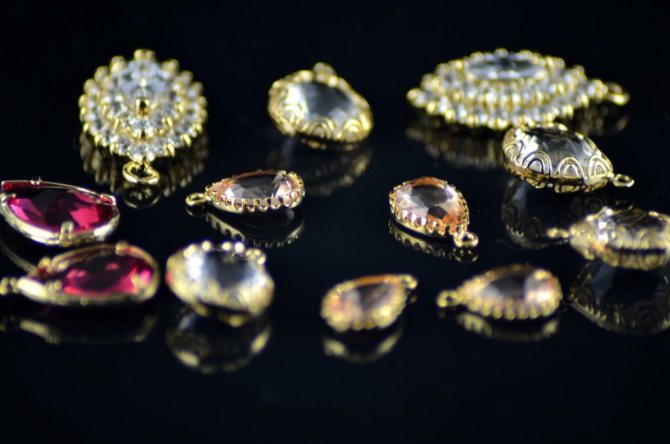
The white metal resembles platinum and goes well with diamonds, which add even more light and create shimmer. Light jewelry made from aurum, palladium and silver are considered universal: they suit everyone and any outfit.
Black
The most sophisticated, attractive option. To obtain it, special galvanic treatment is required. Products are also sometimes coated with amorphous carbon or rhodium or ruthenium. The black tint is also achieved by mixing chromium with cobalt. The best way to complement and make the beauty of black gold more expressive are white and black diamonds, sapphires, and rubies.
Brown
It is hard and contains a large amount of copper. However, it is not only thanks to this that the metal becomes brown; the main role is played by repeated chemical treatment. Gold rings, pendants, brooches, bracelets rarely come in exclusively brown tones. Usually they combine different shades: pink, yellow, white.
Green tones
You can get a pleasant olive tint if you add potassium to the aurum. A little silver turns gold into greenish shades. The more of it, the lighter the metal becomes: from yellowish-green to yellowish-white and eventually becomes white.
From blue to blue
So far, only a master from Argentina has succeeded in turning yellow gold into blue. He did not share his formula with anyone. Theoretically, the alloy should at least contain indium.

As for blue, it's easier to get. A ligature with chromium and iron is used. One “but”: blue gold is very fragile and can oxidize. As a rule, products are decorated with small inserts of blue metal and placed in places that are less likely to come into contact with human skin.
Black gold
One of the latest trends in jewelry production. To obtain black gold, it is combined with cobalt and chromium, but the trouble is that these metals do not mix well. The exact manufacturing technology of this rare, expensive and elegant metal still remains a mystery to most manufacturers. But some have still learned to obtain a similar effect using ruthenium or rhodium, applying them to the surface of products using the galvanic method or, for example, by patination with oxygen and sulfur.
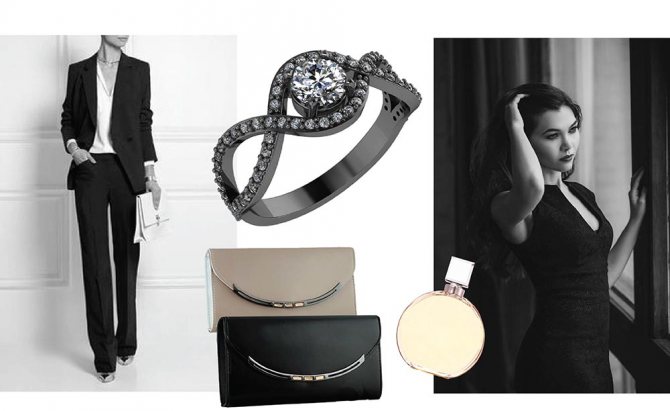
Yellow gold remains the most popular. But if you are bored with the shade of the sun or simply don’t suit your look, you don’t have to change your favorite metal. Black, white, colored, different shapes and designs, with or without stones, smooth or openwork - you will find a product to suit any preference.
Colored gold in blue and cyan tones
Blue colored gold, along with pink, dominates modern jewelry fashion trends. However, the production of such precious metal is complex and expensive. It is made by alloying with rare earth indium, the predominance of which determines the color saturation. Sometimes indium is not added to the melt, but is sprayed onto the surface of the gold product, subjecting it to further heat treatment. At the same time, the metals are mixed, and the jewelry begins to cast a pleasant heavenly blue.
The varied shades of colored gold jewelry are beautiful and amazing. Jewelry made from this metal amazes with its extraordinary sophistication. However, what may be even more surprising is that gold began to be used in... cooking! But this is a topic for a separate article. This is what modern gold has become - diverse, beautiful, magically attractive and even delicious!
More news
- Domestic banks are accelerating the export of gold from Russia
- Island coconut paradise and pirate treasures
- How Covid helped a French family get rich
to news list
